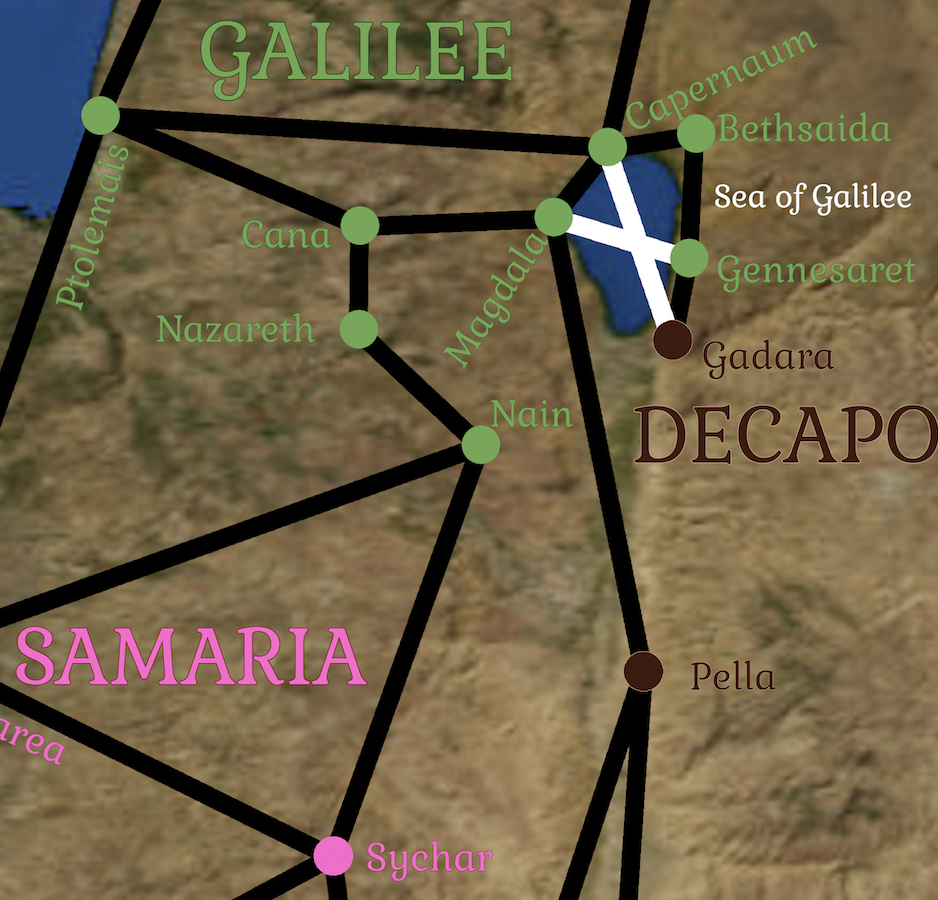In my last post, Jesus and His disciples started in Judea and headed towards Galilee, but they had to pass through Samaria. There Jesus encountered a woman at Jacob’s well, near Sychar. He called her to Himself and spent two days there leading a great revival.
After the two days he went out from there and went into Galilee. … Jesus came therefore again to Cana of Galilee, where he made the water into wine. (John 4:43,46a)
This is Jesus’ second visit to Cana. We have already looked at this village, but we haven’t looked very closely at Galilee as a whole. The bulk of Jesus’ ministry, as reported in the synoptic gospels (Matthew, Mark, and Luke), is spent in this region, so today I want to focus on what we know about this part of Israel.
It has always been curious to me that Judea is a prominent area for the Jews, Samaria is not, but then Galilee is again. What is the story here?
In his excellent book, Understanding the Land of the Bible, O. Palmer Robertson describes Galilee almost poetically:
Slopes descending from the mountains of Samaria connect Galilee with the rest of Palestine. Intermittent passes open this northern territory to the flat coastal plains along the Mediterranean that lead to Egypt and the rest of North Africa. Prominent among these passes was the one guarded by the fortress city of Megiddo, always ready to stand against advancing armies. … A second prominent feature of Galilee’s terrain are the broad plains running west to east on a slight diagonal from the Mediterranean to the Jordan River. Broken here and there with mountains, such as Gilboa where Saul fell and Tabor where Deborah assembled her troops, these broad expanses known as Jezreel (or Esdraelon) provided fertile soil for crops to grow and ample space for chariots to maneuver. … Across these plains marched the Assyrian armies of Sennacharib and the Babylonian troops of Nebuchadnezzar. The Medo-Persian, the Greek, the Roman, and the Crusader armies each in their turn trudged over this same soil. … But more significant than all these goings and comings of rising and falling nations was the strategic role of this same Galilee of the Gentiles in the spread of the Gospel of God to all the nations of the world. … Jesus opened his public ministry by deliberately situating himself at Capernaum so he could reach out to touch all nations with his Gospel. At this locale he could preach to all the peoples of the world — not simply the Jews — about the worldwide “kingdom of heaven” that was near (Matt 4:17).
Robertson hints at some of the key history of this region, but let’s dive a little deeper.
The area known as Galilee largely aligns with the tribal allotments for Asher, Zebulun, and Naphtali. After the conquest, Judges 1 describes the success of each of the tribes in driving out the original gentile inhabitants. The description starts well with Judea in the south, but as it moves north it gets worse. First, we encounter pockets where the Israelites fail and the gentiles continue to live among them (e.g. Judges 1:21), but by the time we get to Asher (Judges 1:32) and Naphtali (Judges 1:33), the script is flipped and the Israelites live among the gentiles.
King Solomon also gave 20 cities to Hiram, the gentile king of Tyre (1 Kings 9:11), although Hiram wasn’t impressed. He called the cities Cabul, or good-for-nothing (1 Kings 9:13).
And thus, from the very beginning, Galilee was “of the gentiles”, as Isaiah described it (Isaiah 9:1, quoted in Matthew 4:15).
But, as Robertson noted, perhaps most significantly, the history of Galilee was shaped by the fact that it was the northern frontier of the promised land. The entry point for all of the invading armies. They were the first conquered and the first carried away captive (2 Kings 15:29). There is no record of these northern tribes ever returning to the land.
As we read last week, a remnant was left in Samaria who intermarried with imported gentiles and intermixed religions, but Galilee was left barren and eventually resettled by various gentile peoples who gradually moved in.
It appears that Jews didn’t return to Galilee until the time of the Hasmonean dynasty, which gained independence when the Seleucid Empire collapsed around 100 BC. The Hasmoneans expanded north out of Judea into Samaria and Galilee. They settled many new cities in the conquered territory, bringing in Jews from the south and perhaps converting many of the gentiles to the Jewish faith. For example, Joseph’s family was clearly from Judea, and Mary at least had cousins in Judea.
And so, by the providence of God, in the fullness of time, God prepared the way for Jesus to preach throughout Galilee of the gentiles, and for the gospel to spread from there to the nations.
—
The map at the top of this post is a snapshot of a portion of the gameboard for Journeys with Jesus.
If you’ve found this interesting and would like to continue to read these stories of the journeys and places in Journeys with Jesus, sign up in the sidebar to receive updates.
Note: all scripture quotes, unless otherwise noted, are from the World English Bible which is in the public domain.

